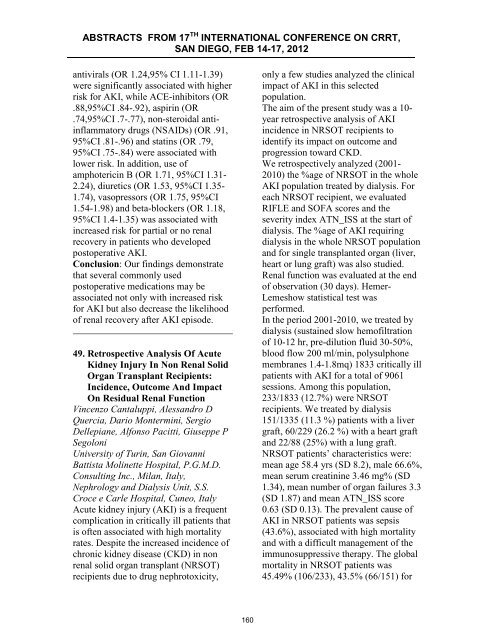ABSTRACTS from 16th International COnference on ... - CRRT Online
ABSTRACTS from 16th International COnference on ... - CRRT Online
ABSTRACTS from 16th International COnference on ... - CRRT Online
You also want an ePaper? Increase the reach of your titles
YUMPU automatically turns print PDFs into web optimized ePapers that Google loves.
<str<strong>on</strong>g>ABSTRACTS</str<strong>on</strong>g> FROM 17 TH INTERNATIONAL CONFERENCE ON <strong>CRRT</strong>,<br />
SAN DIEGO, FEB 14-17, 2012<br />
antivirals (OR 1.24,95% CI 1.11-1.39)<br />
were significantly associated with higher<br />
risk for AKI, while ACE-inhibitors (OR<br />
.88,95%CI .84-.92), aspirin (OR<br />
.74,95%CI .7-.77), n<strong>on</strong>-steroidal antiinflammatory<br />
drugs (NSAIDs) (OR .91,<br />
95%CI .81-.96) and statins (OR .79,<br />
95%CI .75-.84) were associated with<br />
lower risk. In additi<strong>on</strong>, use of<br />
amphotericin B (OR 1.71, 95%CI 1.31-<br />
2.24), diuretics (OR 1.53, 95%CI 1.35-<br />
1.74), vasopressors (OR 1.75, 95%CI<br />
1.54-1.98) and beta-blockers (OR 1.18,<br />
95%CI 1.4-1.35) was associated with<br />
increased risk for partial or no renal<br />
recovery in patients who developed<br />
postoperative AKI.<br />
C<strong>on</strong>clusi<strong>on</strong>: Our findings dem<strong>on</strong>strate<br />
that several comm<strong>on</strong>ly used<br />
postoperative medicati<strong>on</strong>s may be<br />
associated not <strong>on</strong>ly with increased risk<br />
for AKI but also decrease the likelihood<br />
of renal recovery after AKI episode.<br />
49. Retrospective Analysis Of Acute<br />
Kidney Injury In N<strong>on</strong> Renal Solid<br />
Organ Transplant Recipients:<br />
Incidence, Outcome And Impact<br />
On Residual Renal Functi<strong>on</strong><br />
Vincenzo Cantaluppi, Alessandro D<br />
Quercia, Dario M<strong>on</strong>termini, Sergio<br />
Dellepiane, Alf<strong>on</strong>so Pacitti, Giuseppe P<br />
Segol<strong>on</strong>i<br />
University of Turin, San Giovanni<br />
Battista Molinette Hospital, P.G.M.D.<br />
C<strong>on</strong>sulting Inc., Milan, Italy,<br />
Nephrology and Dialysis Unit, S.S.<br />
Croce e Carle Hospital, Cuneo, Italy<br />
Acute kidney injury (AKI) is a frequent<br />
complicati<strong>on</strong> in critically ill patients that<br />
is often associated with high mortality<br />
rates. Despite the increased incidence of<br />
chr<strong>on</strong>ic kidney disease (CKD) in n<strong>on</strong><br />
renal solid organ transplant (NRSOT)<br />
recipients due to drug nephrotoxicity,<br />
<strong>on</strong>ly a few studies analyzed the clinical<br />
impact of AKI in this selected<br />
populati<strong>on</strong>.<br />
The aim of the present study was a 10-<br />
year retrospective analysis of AKI<br />
incidence in NRSOT recipients to<br />
identify its impact <strong>on</strong> outcome and<br />
progressi<strong>on</strong> toward CKD.<br />
We retrospectively analyzed (2001-<br />
2010) the %age of NRSOT in the whole<br />
AKI populati<strong>on</strong> treated by dialysis. For<br />
each NRSOT recipient, we evaluated<br />
RIFLE and SOFA scores and the<br />
severity index ATN_ISS at the start of<br />
dialysis. The %age of AKI requiring<br />
dialysis in the whole NRSOT populati<strong>on</strong><br />
and for single transplanted organ (liver,<br />
heart or lung graft) was also studied.<br />
Renal functi<strong>on</strong> was evaluated at the end<br />
of observati<strong>on</strong> (30 days). Hemer-<br />
Lemeshow statistical test was<br />
performed.<br />
In the period 2001-2010, we treated by<br />
dialysis (sustained slow hemofiltrati<strong>on</strong><br />
of 10-12 hr, pre-diluti<strong>on</strong> fluid 30-50%,<br />
blood flow 200 ml/min, polysulph<strong>on</strong>e<br />
membranes 1.4-1.8mq) 1833 critically ill<br />
patients with AKI for a total of 9061<br />
sessi<strong>on</strong>s. Am<strong>on</strong>g this populati<strong>on</strong>,<br />
233/1833 (12.7%) were NRSOT<br />
recipients. We treated by dialysis<br />
151/1335 (11.3 %) patients with a liver<br />
graft, 60/229 (26.2 %) with a heart graft<br />
and 22/88 (25%) with a lung graft.<br />
NRSOT patients’ characteristics were:<br />
mean age 58.4 yrs (SD 8.2), male 66.6%,<br />
mean serum creatinine 3.46 mg% (SD<br />
1.34), mean number of organ failures 3.3<br />
(SD 1.87) and mean ATN_ISS score<br />
0.63 (SD 0.13). The prevalent cause of<br />
AKI in NRSOT patients was sepsis<br />
(43.6%), associated with high mortality<br />
and with a difficult management of the<br />
immunosuppressive therapy. The global<br />
mortality in NRSOT patients was<br />
45.49% (106/233), 43.5% (66/151) for<br />
160
















